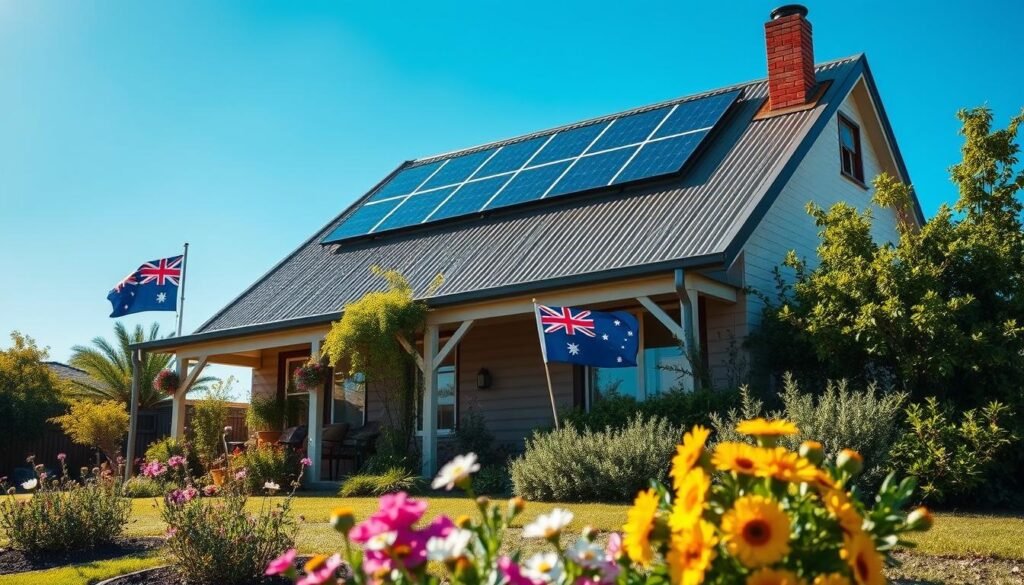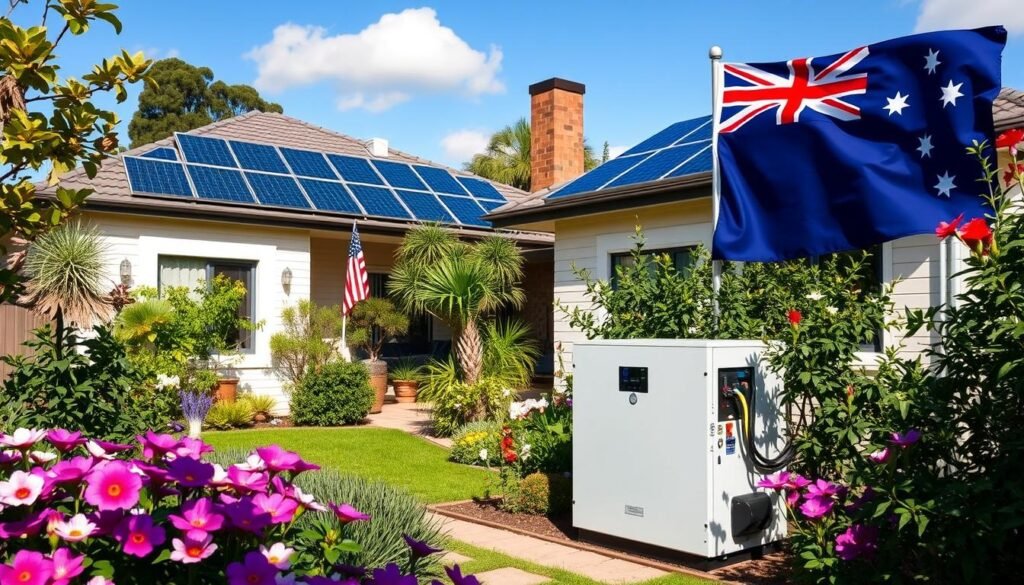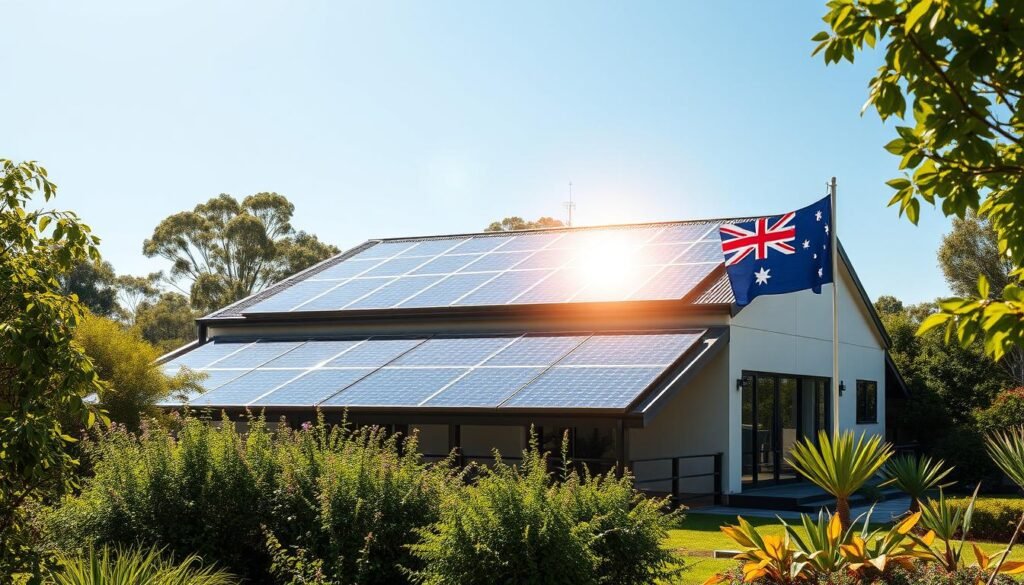Imagine cutting your energy bills and using less grid power. You could also get a big government rebate. This is happening in New South Wales with a new solar battery rebate scheme.
The rebate started on November 1. It will save NSW homeowners $800 to $2,200 on solar batteries. The maximum saving is $2,400. This could lead to more people getting solar batteries to save money and live sustainably.

Steve Fitts from Sydney is one of the first to get the rebate. He saved $1,800 on his solar battery. With the cost of living rising, this rebate is a big help.
By using the rebate, Fitts could get a bigger battery. This means he uses less fossil fuel and becomes more energy independent.
About 890,000 NSW homes already have solar panels. The rebate could make many more homes get solar batteries. This could really boost the battery industry as more people see the benefits of clean energy.
News Highlights
- NSW homeowners can save between $800 and $2,200 on solar battery installations through the new energy rebate scheme
- The rebate, which took effect on November 1, aims to drive solar battery uptake and help residents reduce their reliance on the grid
- Sydney resident Steve Fitts saved $1,800 on his solar battery, enabling him to opt for a larger system and decrease his fossil fuel dependence
- With 890,000 NSW homes already having solar panels, the potential for widespread solar battery adoption is significant
- The rebate is expected to stimulate growth in the solar battery industry and encourage more Aussies to embrace sustainable energy solutions
NSW Government Launches Solar Battery Rebate Scheme
The NSW government has launched a new solar battery rebate scheme. It aims to help homeowners and businesses become more energy independent. This move is part of the state’s goal to cut emissions and use less grid power during peak times.
Eligible homes and businesses with solar panels can get a rebate of $1,600 to $2,400 for a new battery. This includes popular brands like Tesla Powerwall and LG Chem RESU. The rebate amount varies based on the battery size and current prices.
| Battery Size | Rebate Range |
|---|---|
| 6.5 kWh | $770 – $1,150 |
| 13.5 kWh | $1,600 – $2,400 |
There’s also an extra $250 to $400 for connecting batteries to a Virtual Power Plant (VPP). This can be claimed twice, with a three-year gap between claims. It’s another way to encourage people to join the scheme.
The rebate is part of NSW’s plan to cut emissions by 70% by 2035. With over a million homes already using solar, the incentives will likely boost battery adoption. This will make the grid more stable and reliable.
Suppliers like 4Eva Energy and Creditex will offer discounts for installation. More suppliers will be added as they get accredited.
“Home batteries offer guaranteed bill reductions for at least 5 years and help create a more resilient grid by participating in Virtual Power Plants,” said a spokesperson from Reposit Power, a company specializing in household batteries.
The scheme starts on 1 November 2024, after months of industry talks. It’s expected to save NSW money and encourage energy self-sufficiency among its people.
How the New Energy Rebate Works
The Australian Government has introduced a new energy rebate to ease the financial burden of rising electricity costs. This $3.5 billion measure will benefit over 10 million households and one million small businesses starting July 1, 2024.

Eligible households will get a $300 rebate on their electricity bills. Small businesses will receive $325. The rebate will be applied automatically as a credit on energy bills in four quarterly installments of $75 each in the 2024-2025 financial year.
Eligibility Criteria for NSW Homeowners
To qualify for the rebate, households must meet certain criteria. The rebate is available to all households, regardless of income, and no registration is needed. Eligible embedded network customers in apartments or retirement villages can also apply for the rebate through state and territory governments.
The NSW Government also offers various rebates to reduce energy bills. These include:
- Low Income Household Rebate
- Gas Rebate
- Family Energy Rebate
- Life Support Rebate
- Medical Energy Rebate
- Seniors Energy Rebate
- Energy Accounts Payment Assistance scheme
To be eligible for these rebates, you must hold specific concession cards from the Commonwealth Department of Human Services or the Department of Veterans’ Affairs.
Rebate Amounts and Potencial Savings
The new energy rebate will significantly reduce costs for households and small businesses. Victorian households can get rebates of up to $300, while small businesses can receive up to $325. The total allocated for electricity bill relief is up to $3.5 billion.
| Customer Type | Rebate Amount | Payment Commencement |
|---|---|---|
| Households | $300 ($75 per quarter) | August 2024 |
| Small Businesses | $325 | August 2024 |
| Embedded Network Households | $300 (one-off payment) | Upon application |
| Embedded Network Small Businesses | $325 (one-off payment) | Upon application |
Switching to a cheaper electricity plan can save you as much or more than the rebate. An ACCC analysis found nearly half of households pay the default offer price. This suggests there’s room for further savings by comparing and switching plans.
Sydney Resident Steve Fitts Benefits from Solar Battery Rebate
Steve Fitts, a Sydney resident, was one of the first to get the NSW government’s solar battery rebate. He saved $1,800 on his solar battery, bringing the cost down from $11,000 to $9,000.
The rebate started on 1st November. It helps NSW homeowners save between $800 and $2,200 on solar batteries. The goal is to make solar storage more affordable and accessible.
Increased Energy Independence and Cost Savings
Fitts chose a solar battery for more energy independence and cost savings. Now, he can store excess energy from his solar panels at night. This cuts down his reliance on the grid and lowers his electricity bills.
“I’ve always been interested in solar energy, but the upfront cost of a battery system was a bit daunting. The rebate made it much more manageable and I’m excited to see the long-term benefits.”
Opting for a Larger Battery with Rebate Savings
The rebate savings let Fitts choose a bigger battery than he thought. This bigger battery will increase his energy independence and savings over time. It means he can store more solar energy, even on cloudy days or when energy demand is high.
As more Sydney residents like Steve Fitts use the rebate, the city will see more solar storage adoption. This move towards clean energy benefits households and helps create a sustainable future for everyone.
Solar Battery Uptake in NSW and Across Australia
Aussies are turning to solar power to cut energy bills and carbon footprint. In NSW, 890,000 homes have solar panels, but solar batteries are less common due to cost. The NSW Government’s new rebate scheme aims to boost solar battery use.
The Peak Demand Reduction Scheme offers up to $2,400 off a new battery. This is part of a $290 million plan to help homes and businesses save on energy. The goal is to have 1 million homes with solar and batteries by 2035, and 1.5 million by 2050.
Australians lead the world in rooftop solar use, with 3.7 million homes having solar panels. States like South Australia, Victoria, and Queensland have launched battery incentives. South Australia’s Big Battery has helped stabilize its grid, while Victoria and the ACT offer no-interest loans for solar batteries. Queensland even offered up to $4,000 for battery rebates.
The Australian Energy Market Operator says 1 million batteries are needed by 2030 for a smooth transition. Solar Citizens advocate for a federal battery rebate like NSW’s. They believe 8GW of batteries are needed by 2030 and should support electric vehicle charging. Home batteries with solar can create virtual power plants, making the grid stronger and reducing fossil fuel use.
The growth of solar battery use in NSW and Australia shows a bright future for renewable energy. With government support, more homes and businesses will switch to clean energy. This will help create a sustainable future for everyone.
Solar Industry’s Response to the NSW Rebate
The solar industry in New South Wales is excited about the new solar battery rebate scheme. Other Australian states have shown it works well. This will help more homeowners use solar energy.

The NSW Solar Battery Rebate 2024 gives homeowners $1,600 to $2,400 off the cost of installing a battery. You can also get $250 to $400 extra for joining a Virtual Power Plant (VPP). This helps the grid and lets you sell extra energy.
Comparison to Other Australian States’ Incentives
Other Australian states have also offered solar battery incentives:
- South Australia gives a $100/kWh rebate, up to $2,000.
- Victoria offers a discount of up to $3,500 on solar battery systems.
- Queensland has interest-free loans and grants for solar batteries and systems.
These incentives help make solar batteries more affordable for homeowners.
You can also read: $260 cost of living boost for aussies
Anticipated Impact on Solar Battery Adoption
The NSW Solar Battery Rebate will likely increase solar battery adoption in the state. It makes batteries cheaper, helping homeowners store and use solar energy better.
| Battery Size | Rebate Amount | Additional VPP Incentive |
|---|---|---|
| Small (≤ 8 kWh) | $1,600 | $250 |
| Large (> 8 kWh) | $2,400 | $400 |
Smart Energy Answers, Australia’s top solar retailer, is ready to help. They will guide homeowners through the rebate process. They offer quality components and after-sales support, playing a big role in the solar industry’s response to the NSW rebate.
“The NSW Solar Battery Rebate 2024 is a game-changer for the solar industry and homeowners alike. It will contribute to a more stable grid, increase renewable energy uptake, reduce greenhouse gas emissions, and enhance energy independence for Australian households.”
Electrify 2515: Piloting Australia’s First Net-Zero Suburb
The federal government has put $5.4 million into the Electrify 2515 project. It aims to make the 2515 postcode area in NSW the first net-zero suburb in Australia. Entrepreneur Saul Griffith, 49, is leading the effort to switch all household machines to renewable energy, cutting out fossil fuels.
The project will help about 500 homes in the area over two years. It will give them electric appliances and vehicles at low prices. Homes could save up to 30% on energy and fuel bills by going electric. This could mean saving $5,000 a year for the average household.
Federal Government’s $5.4 Million Investment
The government’s $5.4 million investment is a big step towards Australia’s climate goals. Saul Griffith, who worked in the US, says cutting emissions by 50% by 2030 is key. He wants to show that electrifying homes can work, inspiring others around the world.
Grants for Solar Batteries and Electric Appliances
People in the 2515 area can get grants for solar batteries and electric appliances. Solar panels will be offered at a low cost to those without them. At the end of two years, households get to keep their home battery.
| Statistic | Value |
|---|---|
| Small-scale solar power systems installed in 2515 postcode (as of June 30, 2022) | 1,349 |
| Estimated funding required to electrify all household machines in 2515 postcode | $20 million |
| Machines requiring electrification in the US | 1 billion |
| Machines requiring electrification in Australia | 100 million |
The Electrify 2515 project aims to cut energy costs and improve health. It also tests if the energy grid can handle widespread electrification. The goal is to show the economic benefits of renewable energy, encouraging others to join in and help Australia reach net-zero.
Long-Term Benefits of Solar Energy Adoption
Choosing solar energy and battery storage brings many benefits to Aussie homes. It cuts down energy costs and lessens reliance on the grid. Solar batteries also help reduce carbon emissions, protecting our environment.
Dr Saul Griffith says solar tech is like buying 20 years of cheap electricity. This leads to big savings on appliance costs.
Solar panel prices have dropped, making it easier for many to go solar. In Australia, the Small-scale Renewable Energy Scheme (SRES) offers financial help. Net metering lets you send extra power back to the grid, reducing your bills.

New South Wales has the Empowering Homes program for solar and battery systems. Solar panels need little upkeep and rarely break down. Homes with solar panels often sell for more, with buyers willing to pay up to $15,000 extra.
Solar energy means lower bills and energy independence. It’s great during power outages or when demand is high. Feed-in tariffs vary by state and provider, letting you earn money from excess power.
| Benefit | Description |
|---|---|
| Lower Energy Bills | Solar panels generate free electricity, reducing reliance on the grid and lowering monthly bills. |
| Financial Incentives | Government schemes like SRES and Empowering Homes provide financial support for solar adoption. |
| Increased Property Value | Homes with solar installations often see a rise in property value, with buyers paying a premium. |
| Environmental Impact | Solar energy reduces carbon footprint, supporting sustainable living and potentially translating into social benefits and future incentives. |
“Investing in solar technology is like purchasing 20 years of low-cost electricity upfront, leading to significant savings when powering appliances.” – Dr Saul Griffith, renewable electricity advocate
Solar panels last 25 to 30 years with little upkeep. They can handle harsh weather well. Advances in technology, like PERC and bifacial panels, boost energy output. Better battery storage makes saving solar power more efficient. As living costs rise, solar energy is a smart choice for long-term savings and independence.
Steps for Homeowners Considering Solar Batteries
If you live in NSW and want a solar battery, start by checking your energy needs. Also, see if your solar panels can work with a battery system.

Then, think about how much money you’ll save in the long run. The NSW Home Battery Rebate can give you $1,600 to $2,400 off the cost. You might also get $250 to $400 extra for joining a Virtual Power Plant (VPP).
Choosing an Approved Provider
It’s important to pick a solar battery provider that’s approved by the government. Look for:
- Experience and reputation in the solar industry
- Quality of products and warranties offered
- Customer service and support
- Competitive pricing and financing options
Applying for the Rebate Post-Installation
Once your solar battery is set up, apply for the rebate online. Your battery must meet certain criteria to qualify:
| Criteria | Requirement |
|---|---|
| Capacity | Between 2kWh and 28kWh |
| Installation Date | On or after 1st November 2024 |
| Provider | Installed by an approved provider |
By taking these steps and using the rebates, NSW homeowners can save money and be more energy independent. This move helps us all use less fossil fuel and makes our future greener.
Conclusion
The NSW solar battery rebate is a big step towards using more renewable energy. It helps homeowners save money on their energy bills. This scheme makes it easier for people to use their solar energy, not just when the sun is out.
It’s part of a bigger effort to help people across Australia. This includes low-income families, pensioners, and those with medical needs. These groups get financial help to use less energy.
Projects like Electrify 2515 show the future of renewable energy is bright. The government is investing in solar batteries and electric appliances. This aims to make suburbs net-zero and cut down on carbon emissions.
The solar industry is excited about the NSW rebate. It’s expected to boost the use of solar batteries. This move will help Australia move towards cleaner energy.
If you’re thinking about getting solar batteries, now is a great time. You can check if your solar panels will work with them. Then, you can see how much money you’ll save with the rebate.
Choosing an approved provider and applying for the rebate is easy. This way, Aussies can help make our future greener. With more states and the federal government supporting green energy, Australia is set to lead the way.
FAQ
The NSW solar battery rebate is a government program. It helps homeowners save money on solar battery installations. The goal is to make homes more energy independent and cut down on grid usage.
Homeowners can save up to $2,400 on solar battery costs. The exact savings vary, but it’s a big help. On average, you could save between $800 and $2,200, with the highest being $2,400.
To get the rebate, you need solar panels already installed. Your chosen battery must meet certain energy standards. Also, the installation must be done by an approved provider.
The rebate helps homeowners store solar energy for later use. This means less need for grid power and fossil fuels. It leads to lower bills and a greener home.
The rebate is set to boost solar battery use in NSW. Currently, many homes have solar panels but few have batteries. The rebate makes batteries more affordable, encouraging more people to get them.
First, check if your solar panels can work with a battery. Then, think about how much you’ll save in the long run. Choose a trusted installer and apply for the rebate online to get your money back.
Solar batteries cut down on energy bills and grid use. They also help the environment by reducing carbon emissions. It’s like buying 20 years of cheap electricity at once, saving you money over time.
